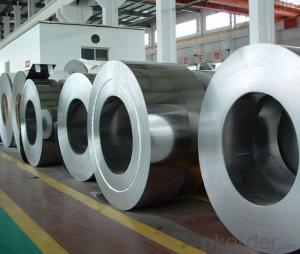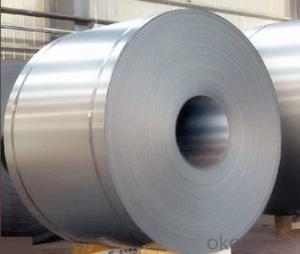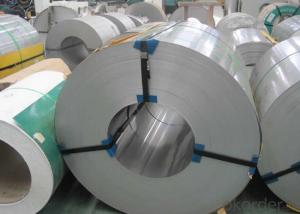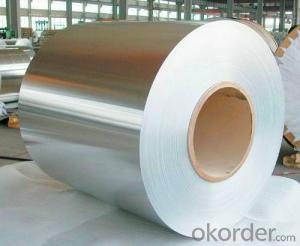Hot / Cold Rolled Stainless Steel Coil 201
- Loading Port:
- Lianyungang
- Payment Terms:
- TT OR LC
- Min Order Qty:
- 100 m.t.
- Supply Capability:
- 5000 m.t./month
OKorder Service Pledge
OKorder Financial Service
You Might Also Like
Hot Rolled Stainless Steel Coil 201 Narrow Strip No.1 Finish
Hot Rolled Stainless Steel 201 half copper Chemical Composition(%) | |||||||
C | Si | Mn | P | S | Ni | Cr | Cu |
0.1 | 0.5 | 10 | 0.04 | 0.01 | 1.20/1.30 | 13.00/14.00 | 0.8/1.0 |
Grade: | 200 Series | Standard: | JIS,AISI,ASTM,GB,DIN | Thickness: | 2.5/3.0/4.0mm |
Width: | 485/510/550/610/1010/1240mm | Place of Origin: | Shanghai China (Mainland) | Brand Name: | CNBM |
Model Number: | 201 | Technique: | Hot Rolled | Application: | Industrial tubes/kitchen/bath |
Certification: | ISO | THK: | 2.5/3.0/4.0mm | Face: | No.1 |
Usage: | tubes/kitchen/bath | Origin: | CHINA | ||
Packaging Detail: For customer's requirement
Delivery Detail: 10-30days
201 Hot Rolled Stainless Steel Coil Specifications
THK:2.3/2.5/3.0/4.0mm
Width:485/510/550/610/1010/1240mm
Face:No.1
201 Hot rolled stainless steel Coil Application
Stainless steel is a production which not easy rust,acid resistance and corrosion resistance,so it is widely
used in light industry,heavy industry,daily necessities and the decoration industry.
201 hot rolled stainless steel coil, use to produce cold rolled stainless steel coil and stainless steel tube, pipe.
201 Hot Stainless Steel Coil Chemical Composition(WT%)
(C):≤0.15, (Si):≤0.75, (Mn):5.5~7.50, (Cr):16.0~18.0, (N):≤0.25, (Ni):3.50~5.50, (P):≤0.060, (S):≤0.030
201 Hot Rolled Stainless Steel Coil
Strength Of Extension:100,000 To 180,000 Psi;
Yield Strength:50,000 To 150,000 Psi
Elongation :55 To 60%;
Modulus Of Elasticity:29,000,000 Psi;
Density :.280lbs/Cubic Inch(7.93g/Cm3)
- Q:What are the dimensions of stainless steel strips?
- The dimensions of stainless steel strips can vary depending on the specific needs and requirements of the application. However, stainless steel strips are commonly available in various thicknesses ranging from 0.1mm to 6mm and widths ranging from 10mm to 2000mm. The length of stainless steel strips can also vary, but it is typically available in coils or rolls of standard lengths, such as 1000mm or 2000mm. Additionally, stainless steel strips can be custom-cut to specific dimensions to suit individual project requirements.
- Q:Are 111 stainless steel strips suitable for pressure vessels?
- No, 111 stainless steel strips are not suitable for pressure vessels. Pressure vessels require materials that have high strength, corrosion resistance, and the ability to withstand high pressure and temperature conditions. While 111 stainless steel may have good corrosion resistance, it lacks the necessary strength and toughness properties required for pressure vessel applications. It is important to use materials that are specifically designed and certified for these applications, such as 316 stainless steel or other specialized alloys.
- Q:What are the factors affecting the corrosion resistance of 111 stainless steel strips?
- There are several factors that can affect the corrosion resistance of 111 stainless steel strips. 1. Composition: The composition of the stainless steel plays a crucial role in its corrosion resistance. The presence of alloying elements such as chromium, nickel, and molybdenum can enhance the corrosion resistance of the steel. In the case of 111 stainless steel, it typically contains 17-19% chromium, which provides excellent corrosion resistance. 2. Surface condition: The surface condition of the stainless steel strips can impact its corrosion resistance. Any imperfections, such as scratches, roughness, or contamination, can create sites for corrosion initiation. Therefore, proper surface preparation and cleaning are essential to maintain the corrosion resistance of the strips. 3. Environmental factors: The environment in which the stainless steel strips are exposed can significantly affect their corrosion resistance. Factors such as temperature, humidity, pH level, and the presence of corrosive substances like acids or chlorides can accelerate the corrosion process. Therefore, it is important to consider the specific environmental conditions in which the 111 stainless steel strips will be used. 4. Passive film formation: Stainless steel forms a passive oxide film on its surface, which provides a protective barrier against corrosion. The ability of the steel to form and maintain this passive film is crucial for its corrosion resistance. Any damage to the film can lead to localized corrosion. Therefore, factors such as exposure to aggressive chemicals or mechanical damage can affect the passive film formation and, consequently, the corrosion resistance. 5. Manufacturing processes: The way the stainless steel strips are manufactured can influence their corrosion resistance. Processes such as heat treatment, cold rolling, and surface finishing can affect the microstructure and surface properties of the steel, which in turn can impact its corrosion resistance. 6. Maintenance and care: Proper maintenance and care of the stainless steel strips can significantly extend their corrosion resistance. Regular cleaning, removal of contaminants, and applying protective coatings can help prevent corrosion and maintain the longevity of the strips.
- Q:Are stainless steel strips resistant to hydrochloric acid?
- Yes, stainless steel strips are generally resistant to hydrochloric acid.
- Q:What are the common dimensions of stainless steel strips?
- The common dimensions of stainless steel strips can vary depending on the specific application and industry requirements. However, some commonly available dimensions include thicknesses ranging from 0.1mm to 3mm, widths ranging from 10mm to 500mm, and lengths ranging from a few meters to coils of several hundred meters.
- Q:What are the different types of slitting for stainless steel strips?
- There are several different types of slitting methods used for stainless steel strips, each with their own advantages and applications. Some of the common types of slitting methods include: 1. Rotary slitting: This is a widely used method that involves the use of circular blades to cut the stainless steel strips. It is suitable for a wide range of thicknesses and can produce high-quality, precise cuts. Rotary slitting is often used for thinner strips. 2. Guillotine slitting: This method involves the use of a guillotine-like blade that moves in a straight line to cut the stainless steel strips. It is generally used for thicker strips and can handle higher volumes of material. Guillotine slitting is known for its speed and efficiency. 3. Crush cutting: Crush cutting is a method that uses two rotating circular blades, with one blade applying pressure to the material while the other blade cuts through it. This method is commonly used for thinner stainless steel strips and is known for its ability to produce clean and straight cuts. 4. Razor slitting: Razor slitting involves the use of a single razor blade to cut the stainless steel strips. This method is often used for thinner gauge materials and can produce very narrow strips. Razor slitting is known for its accuracy and precision. 5. Shear slitting: Shear slitting is a method that uses two blades to cut the stainless steel strips. The blades move past each other in a scissor-like motion to make the cut. This method is commonly used for thicker strips and is known for its ability to handle high volumes of material. Each of these slitting methods has its own advantages and is suitable for different applications. The choice of slitting method depends on factors such as the thickness of the stainless steel strips, the required accuracy of the cuts, and the desired production volume.
- Q:Can stainless steel strips be used in watchmaking?
- Yes, stainless steel strips can be used in watchmaking. Stainless steel is commonly used in watchmaking due to its durability, corrosion resistance, and aesthetic appeal. It is often used for watch cases, bands, and other components.
- Q:Can stainless steel strips be used in architectural façade systems?
- Yes, stainless steel strips can be used in architectural façade systems. Stainless steel is a highly durable and corrosion-resistant material, making it suitable for use in exterior applications such as architectural façades. Stainless steel strips can be used to create sleek and contemporary designs, adding a modern aesthetic to buildings. Additionally, stainless steel offers excellent weather resistance and requires minimal maintenance, making it a popular choice for architects and designers in creating long-lasting and visually appealing façade systems.
- Q:Can stainless steel strips be used in chemical storage tanks?
- Yes, stainless steel strips can be used in chemical storage tanks. Stainless steel is known for its corrosion resistance properties, which makes it suitable for storing various chemicals. It provides resistance to a wide range of corrosive substances, including acids, bases, and solvents. Additionally, stainless steel has excellent strength and durability, allowing it to withstand the harsh conditions often found in chemical storage tanks. Its inert nature also ensures that it does not react with the stored chemicals, thus preserving the integrity of the stored materials. Overall, stainless steel strips are a popular choice for chemical storage tanks due to their corrosion resistance, strength, and durability.
- Q:What is the corrosion resistance of stainless steel strips?
- The corrosion resistance of stainless steel strips is excellent due to the presence of chromium in its composition, which forms a protective oxide layer on the surface, preventing rust and corrosion.
1. Manufacturer Overview |
|
|---|---|
| Location | |
| Year Established | |
| Annual Output Value | |
| Main Markets | |
| Company Certifications | |
2. Manufacturer Certificates |
|
|---|---|
| a) Certification Name | |
| Range | |
| Reference | |
| Validity Period | |
3. Manufacturer Capability |
|
|---|---|
| a)Trade Capacity | |
| Nearest Port | |
| Export Percentage | |
| No.of Employees in Trade Department | |
| Language Spoken: | |
| b)Factory Information | |
| Factory Size: | |
| No. of Production Lines | |
| Contract Manufacturing | |
| Product Price Range | |
Send your message to us
Hot / Cold Rolled Stainless Steel Coil 201
- Loading Port:
- Lianyungang
- Payment Terms:
- TT OR LC
- Min Order Qty:
- 100 m.t.
- Supply Capability:
- 5000 m.t./month
OKorder Service Pledge
OKorder Financial Service
Similar products
New products
Hot products
Hot Searches
Related keywords





























